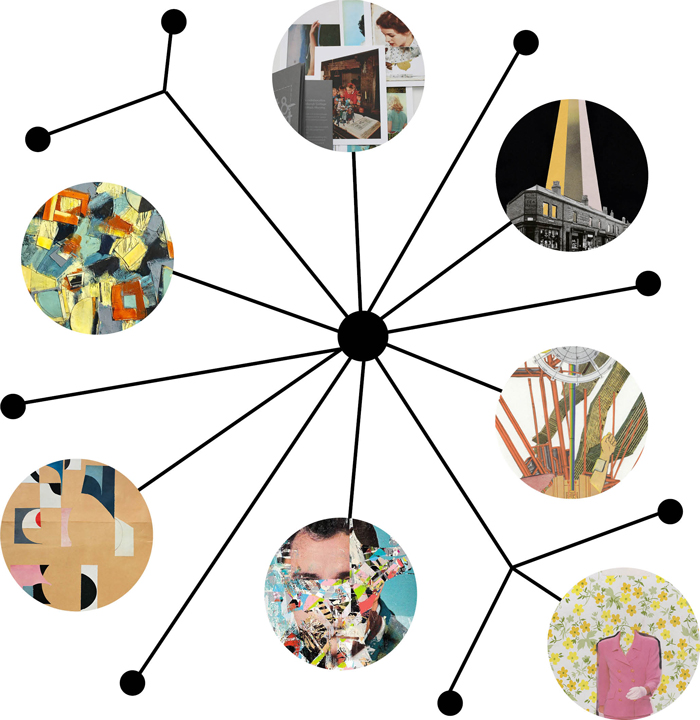
KOLAJ INSTITUTE
Collage Communities
The social and economic organization of the 21st century places great emphasis on the individual. Over a century, Modernism pushed the idea that humans were lone operators, each responsible for their success or failure. As this relates to artists, we wrote about this in Kolaj #19, “Too often we talk about art as the product of independent genius. The artist as mythical figure toils alone in their studio to weave a golden thread of creativity into a magnificent oeuvre. In only the rarest, most tragic instances is this true. Most artists, and in particular most great artists, surround themselves with smart, intuitive, thoughtful people with whom they engage on a regular basis. Good art is inherently social and the production of art is a community-based activity.”
The collage community is unique in the larger art world in that communities and collectives play an important role in the production and promotion of the art form. Collage groups organize exhibitions, run online calls to artists, facilitate exchange across borders. While the presence of these groups is felt, who they are, how they function, and how they are evolving over time is poorly understood.
With that in mind, Kolaj Institute announces the creation of The International Directory of Collage Communities. The directory will survey and document collage collectives, meet-ups, ongoing collaborative projects, and groups whose focus and mission involves collage as a medium or genre in some way. The information will be presented in an online directory and as a printed book that will highlight communities and the artists involved. The first publication will be released in October 2020.
“I have made long lasting friendships with the other artists in my collage krewe,” says Kolaj Institute Coordinator, Christopher Kurts. “Their willingness to share their experiences, to embrace each other and be vulnerable during the creative process, and, most importantly, their support has made me the artist I am today. I am doing this work because I believe that collecting these groups into a single directory will make it easier for others to connect with communities that give them a sense of belonging. And where no such communities exist, this directory can serve as a road map for creating their own.”
“I believe that collecting these groups into a single directory will make it easier for others to connect with communities that give them a sense of belonging. And where no such communities exist, this directory can serve as a road map for creating their own.”
The International Directory of Collage Communities is made possible through the support of donations to Kolaj Institute. The mission of Kolaj Institute is to support artists, curators, and writers who seek to study, document, & disseminate ideas that deepen our understanding of collage as a medium, a genre, a community, and a 21st century movement. Your contribution to Kolaj Institute will allow this project to take root and to create opportunities for artists, curators, and writers working to deepen our understanding of collage, art history, and the role of art in our communities.
By documenting and mapping these communities, Kolaj Institute hopes to develop a picture of the collage movement: how collage artists are working together, how they are diffusing collage, and what challenges they face mobilizing an art community.

Kolaj Institute also hopes that collage artists will use the directory to connect with collage communities as they travel and find ways to be a link between their home community and communities abroad.
Kolaj Institute invites collage communities to submit to the directory. There is no cost to be included in the directory. Authorized representatives of groups are invited to submit using the online tool. For those who are not the authorized representative of a group, we welcome suggestions of groups, collectives, and projects via email.
SEE THE DIRECTORY | REGISTER YOUR GROUP
You Make Kolaj Institute Possible.
The extent to which Kolaj Institute can achieve its mission will depend on the degree to which the collage community supports its work. Kolaj Institute is not possible without the support of people like you who believe investing in the collage community and supporting artists is a worthy endeavour.
Please consider making a donation today.
IMAGE CAPTION: Image details, clockwise from top: “Cut & Post” (2018) from the Edinburgh Collage Collective; The Handsworth Herald by Exist Less (2019) from the Birmingham Collage Collective; Organic Construction by Christopher Kurts (2019) from the Mystic Krewe of Scissors & Glue; from the “Portraits” series (2019) from El Club de Collage (Quito); collage by Madame Gilles (2019) from Quebec Collage; Dos by Jesse Willems (handcut collage; 2019) from Coupee Collage Collective; TGIF by Ellen Kierr Stein from the Atlanta Collage Society. Images courtesy of the artists.
